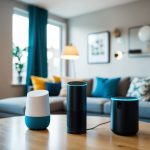Mastering Smart Home Technology for Relaxed Living
Energy-Efficient Lighting Solutions
Adopting energy-efficient lighting solutions reduces energy consumption and enhances home ambiance. Recent developments in technology make it easier to create a comfortable and inviting environment while being mindful of energy use.
Advances in LED and Energy-Saving Technologies
LED technology has revolutionized energy-efficient lighting. By converting electricity into light through a semiconductor, LEDs use less power and have a longer lifespan compared to traditional bulbs. They are available in various color temperatures, providing flexibility for different lighting needs and moods.
Smart lights, often using LED technology, can be controlled remotely via mobile apps or voice-activated devices. This allows for scheduling and setting personalized lighting scenes. Dimming functions not only save additional energy but also extend the lifespan of bulbs. Energy-saving bulbs like compact fluorescent lamps (CFLs) have also improved, although LEDs remain more popular for their immediate brightness and lack of warm-up time.
Optimizing Natural Lighting and Ambiance
Optimizing natural light involves strategic placement of windows, skylights, and reflective surfaces to enhance illumination during daytime. Properly utilized, natural lighting reduces reliance on artificial lights and improves well-being by connecting indoor spaces with the outdoors.
Ambient lighting aims to create an inviting atmosphere by incorporating indirect light sources, reducing shadows, and mimicking natural light patterns. This can be achieved with strategically placed lamps, light strips, and wall sconces. Combining natural light with ambient lighting techniques helps create a harmony between functionality and comfort, resulting in aesthetically pleasing and energy-efficient environments.
Leveraging Voice Assistants for Smart Home Control
Smart home technology offers convenience by using voice assistants to control various devices. The integration of Amazon Alexa and Google Assistant allows users to perform numerous tasks such as adjusting lighting, managing home security, and controlling entertainment systems.
Integration with Amazon Alexa
Amazon Alexa acts as a central hub for many smart devices. It facilitates seamless control through voice commands. Users can pair a wide range of compatible devices like lights, thermostats, and security systems. Setting up routines enables complex sequences of actions with a single command. For instance, saying “Alexa, good night” could lock doors, turn off lights, and lower thermostat settings simultaneously.
Alexa Skills enhance functionality by allowing users to customize their interactions. The Alexa app provides an interface for managing these skills and connected devices. Users can also remotely control their home environment via the app when away. Ensuring solid Wi-Fi coverage and updated device firmware further enhances performance and reliability.
Google Assistant and Smart Home Devices
Google Assistant offers robust support for smart home devices, allowing control through natural language processing. It integrates efficiently with Google’s ecosystem and other compatible third-party devices. By recognizing individual voices, it provides personalized experiences for different household members, adjusting responses and actions accordingly.
Setting up Google Assistant is straightforward with the Google Home app. It supports a wide variety of smart home devices, including lights, speakers, and security cameras. Users can create routines for daily tasks, like playing morning news or adjusting lights at sunset. Ensuring devices are connected to the same network and firmware is kept up-to-date optimizes performance.



